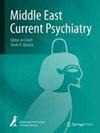Psychological assessment of violent behaviors in schizophrenic patients followed up in My EL Hassan health center of Kenitra, Morocco
IF 1.6
Q3 PSYCHIATRY
引用次数: 0
Abstract
Disorders of the aggressive behavior frequently mark the entry in schizophrenia. They are not specific and very varied. The objective of this study was to assess the different risk factors associated with the manifestation of violent and aggressive behavior of schizophrenic patients who follow consultations in service of psychiatry at Kenitra, Morocco. One-hundred twenty-seven patients with schizophrenia were included, and the Modified Overt Aggression Scale (MOAS) and Positive and Negative Syndrome Scale (PANSS) were used respectively to assess the state of aggressiveness and to identify the type of psychotic symptomatology of schizophrenic patients. Clinical and sociodemographic data were obtained from all patients. The study shows that criminal history, drug addiction, motives for aggressiveness, and the moment of aggressiveness are all potential factors for aggression, and the profile of the patient likely to take the act is that of young schizophrenics under 39 years old, predominantly male, and the majority are single. Judicial history, habits toxic, and the positive psychotic symptoms are reported as the most frequently risk factors. The index of Cronbach (0.64) showed a strong connection between the four items of aggression and strong relation between MOAS and PANSS categories has been shown by independent test (p < 0.001). Aggressive behavior is a frequent symptom of schizophrenia in studied population and poses many clinical challenges. It requires collaboration with the patient for handling difficult situations.对摩洛哥凯尼特拉 My EL Hassan 健康中心随访的精神分裂症患者暴力行为的心理评估
攻击性行为障碍是精神分裂症的常见病因。它们没有特异性,而且种类繁多。本研究的目的是评估与摩洛哥凯尼特拉精神科就诊的精神分裂症患者暴力和攻击行为表现相关的不同风险因素。研究共纳入了 127 名精神分裂症患者,并分别使用了改良外显攻击行为量表(MOAS)和阳性与阴性综合征量表(PANSS)来评估精神分裂症患者的攻击性状况,并确定其精神病症状类型。研究还获得了所有患者的临床和社会人口学数据。研究结果表明,犯罪史、吸毒成瘾、攻击动机和攻击时刻都是导致攻击行为的潜在因素,可能采取攻击行为的患者特征是 39 岁以下的年轻精神分裂症患者,以男性为主,大多数是单身。据报告,司法史、习惯中毒和阳性精神病症状是最常见的危险因素。Cronbach 指数(0.64)显示,四个攻击行为项目之间存在紧密联系,MOAS 和 PANSS 类别之间的紧密联系也通过独立检验得到了证实(P < 0.001)。在研究人群中,攻击行为是精神分裂症的常见症状,给临床带来了许多挑战。它需要与患者合作,以处理棘手的情况。
本文章由计算机程序翻译,如有差异,请以英文原文为准。
求助全文
约1分钟内获得全文
求助全文
来源期刊

Middle East Current Psychiatry
Medicine-Psychiatry and Mental Health
CiteScore
3.00
自引率
0.00%
发文量
89
审稿时长
9 weeks
 求助内容:
求助内容: 应助结果提醒方式:
应助结果提醒方式:


